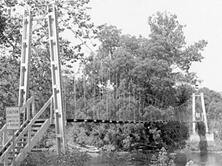 A suspension footbridge over the Little Tennessee River (Macon County Bridge 330) in Cowee, built in 1964 on the site of 1948 and 1916 predecessors (source: NCDOT bridge inspection files).
A suspension footbridge over the Little Tennessee River (Macon County Bridge 330) in Cowee, built in 1964 on the site of 1948 and 1916 predecessors (source: NCDOT bridge inspection files).
Pedestrian suspension footbridges found in the mountains of western North Carolina are known colloquially as swinging bridges because of their notorious bounciness.
Whether a modest footbridge or a long-span highway bridge, the principles of suspension technology are the same. A continuous cable supports the deck by means of suspenders. The cable is in tension, and thus materials such as rope, bamboo and wire with a high resistance in tension historically have been very suitable for the type and usually quite economical.
Suspension footbridges were built in numbers during the late 19th and early 20th centuries. A combination of topography, isolation, rural poverty, few good roads, many families without automobiles, and limited resources for building bridges provide a context for why the suspension footbridge was well-suited to Appalachia.
Mountain rivers frequently flood and the inexpensive footbridges could be quickly built and easily replaced. They also were a way to provide alternate all-season crossings for isolated farms and residences.
The footbridges were often in narrow valleys, constructed to provide access from the road or railroad on one side of a stream to houses, fields or paths on the opposite bank. The bridges were used by residents to walk to the store, post office, mailbox, church or school.
Unfortunately, none of the first-generation, locally built, suspension footbridges are known to survive. All of the examples identified are second or later generation examples built as replacement bridges by the State Bridge Maintenance Unit from 1947 to 1965. Most have been rebuilt once or twice since then.
The bridges are largely composed of salvaged or modern stock materials such as steel rods, bolts, washers, dimensional lumber, and woven wire fence that are commonly found in state maintenance yards. With few exceptions, the towers are salvaged beams, particularly truss members from old highway bridges, that have been cut up and welded together.
In 2005 NCDOT maintained 21 suspension footbridges in Graham, Jackson, Macon, Mitchell, Swain and Yancey counties. The oldest swinging bridge in the state, and one of the most complete, was built by the Maintenance Unit in 1947 northwest of Bakersville (on the site of an earlier footbridge) to provide a safe path for children crossing Big Rock Creek on their way to school (Mitchell County Bridge 223).